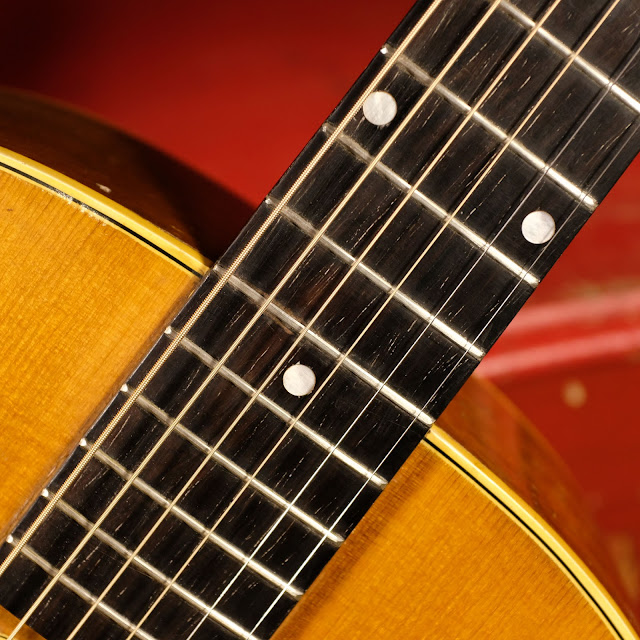1953 Gibson J-50 Slope Dreadnought Guitar
How about this guitar? A consignor sent it to me and it was a ton of work to get going, but it was definitely worth the effort. It's a punchy, dry, crisp, loud, and full bruiser that can easily flit between D-18-style punch and cut and folksy strumming or fingerpicking. This is why I love those early '50s Gibsons -- they're all-arounders that don't disappoint and they're built to last.
This one dates to '53 per its factory order number and its all-original save a new bone saddle, the two pearl dots on the bridge, and the new Kluson-brand buttons on the old Kluson tuners. It only has a few minor cracks -- a tiny one to the treble edge of the pickguard, a small one next to the inside edge of the pickguard, a ~4" hairline at the bass waist and a ~2" hairline in the same area -- and the all-original finish looks great, too.
My work included a neck reset, fret level/dress, bridge reglue and saddle-slot relocation, brace repairs to the top, cleats and sealing (where necessary) to the cracks mentioned above, reglue of all the back braces (most were rattling around in the guitar when it came) and replacement of two center-seam linings on the back, a new bone saddle, and a general setup. It plays beautifully and for heavy-handed flatpicking (like I'm doing in the video clip), the action may be a hair low at its spot-on 3/32" EA and 1/16" DGBE at the 12th fret. The strings are 54w-12, the neck is straight with a functioning truss rod, and it's good to go. The frets have plenty of life left and are the usual smaller Gibson stock from the time.
This guitar's top practically glows. The original finish shows weather-check throughout and minor scratching and scuffing here and there -- with most of it confined to the back.
The original plastic nut, truss rod cover, and tuners are extant. The buttons for the tuners are new replacements, however.
The rosewood board has a ~12" radius to it and pearl dots. The nut is 1 11/16" and the neck profile is "home base" Gibson with a medium C-shape to it. This has a 24 3/4" scale.
There's some pickwear around the soundhole, as you can see.
This is the original bridge, though after regluing it I had to fill the old saddle slot and cut a new one. My new slot is a drop-in rather than a through-slot like the original as I prefer them. It'd be easy-enough to cut it into a through-slot, though I like the easy action adjustments via shims of a drop-in saddle.
The bridge pins and endpin appear to be original. The bridge itself looks like it was glued improperly a couple of times and the disturbed finish at the very front edge of the bridge is from chipped-off dried glue gunk that came off when I took the bridge up. I reglued it where the original bolt-holes said it should be and then adjusted the setup from there. When it was made, the original saddle was in the wrong spot to begin with and would've always played flat up the neck in the past.
There's good back-angle on the saddle, I lightly slotted "string ramps" behind it, and there's plenty of adjustment room on the saddle, too. It sits 1/8" above the bridge.
In the above photo, you can see a faint line in the grain -- this is a hairline crack I sealed and cleated. Just to the inside of the binding at the waist you can also see a small 2" or so hairline crack that's entirely over braces or kerfing -- so I just sealed it up. Those are very common on J-45-type guitars.
Here's a shot with the angle a little different so you can see what the silking in the top is like...
There are no cracks on the back or sides and the mahogany on it glows a nice, medium brown.
I lubed and re-buttoned the tuners and they're working great.
There's average scratching throughout the back, but it looks good.
I had to replace two missing sections of center-seam back lining. Here's the first.
Here's the second.
An old, arched-lid hard case comes with the guitar. I'm not sure at all if it's original or not as it appears to be more suited to an archtop guitar.



























Comments